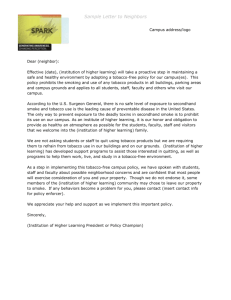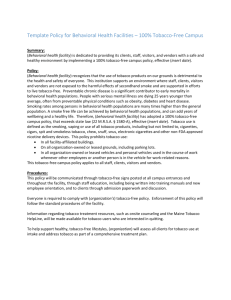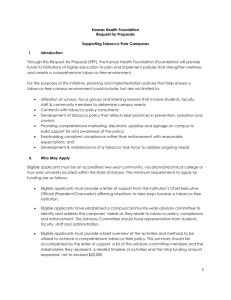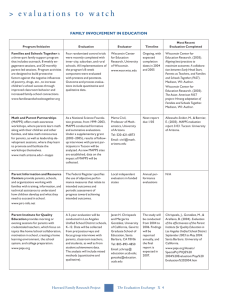Communities Putting Prevention to Work… IN
advertisement
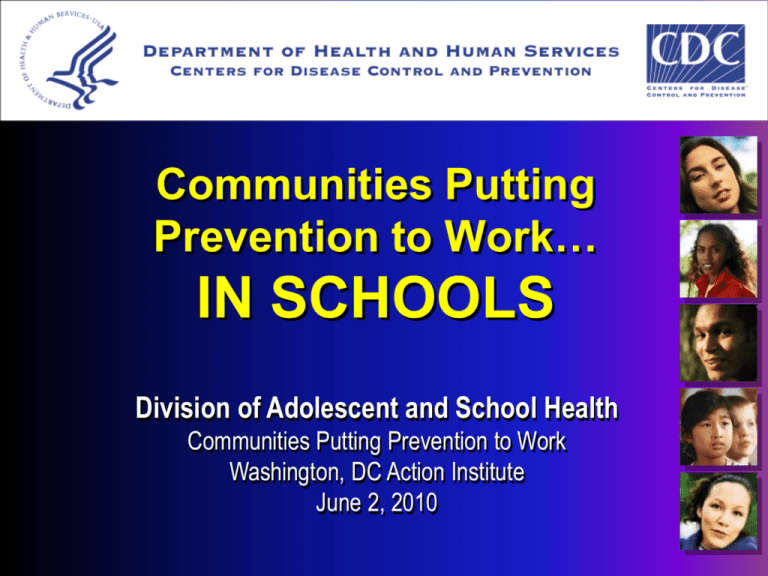
Communities Putting Prevention to Work… IN SCHOOLS Division of Adolescent and School Health Communities Putting Prevention to Work Washington, DC Action Institute June 2, 2010 DASH Mission ■ To promote the health and well being of children and adolescents so they become healthy and well-functioning adults. 2 www.cdc.gov/healthyyouth Key Messages ■ Young people and schools are central to prevention ■ Health is academic ■ We know what needs to be done: MAPPS strategies for schools ■ Despite immense challenges, we have many reasons to be optimistic Key Messages ■ Young people and schools are central to prevention ■ Health is academic ■ We know what needs to be done: MAPPS strategies for schools ■ Despite immense challenges, we have many reasons to be optimistic Why Youth? ■ Health risk behaviors are established in childhood and adolescence ■ Physiological processes leading to chronic diseases begin in childhood and adolescence ■ It’s easier to prevent the adoption of health risk behaviors than to change established behaviors ■ Chronic disease health risks are already common among young people Consequences of Obesity in Children % of children, aged 5-17, with 1 or more risk factors for heart disease: % of children, aged 5-17, with 2 or more risk factors for heart disease: 26% Freedman DS et al. JPediatr 2007;150(1):12-17 13% Consequences of Obesity in Children % of children, aged 5-17, with 1 or more risk factors for heart disease: % of children, aged 5-17, with 2 or more risk factors for heart disease: 26% 70% Freedman DS et al. JPediatr 2007;150(1):12-17 13% 39% Percentage of U.S. Children and Adolescents Who Were Obese, 1963-2008* 19.6 20 18.7 15 10 4.6 5 4.2 Ages 6-11 Ages 12-19 0 1963-70** 1971-74 1976-80 1988-94 1999-2000 2001-02 2003-06 2007-08 *>95th percentile for BMI by age and sex based on 2000 CDC BMI-for-age growth charts. **1963-1970 data are from 1963-1965 for children 6-11 years of age and from 1966-1970 for adolescents 12-17 years of age. CDC, National Center for Health Statistics Percentage of High School Students Who: ■ Currently smoke cigarettes: 20% ■ Do not eat fruits and vegetables 5 or more times per day: 79% ■ Do not meet recommended levels of physical activity: 83% ■ Do not participate in 60 or more minutes of physical activity on any day: 25% Source: CDC, National Youth Risk Behavior Survey, 2007 Government Agencies Family Key Messages ■ Young people and schools are central to prevention ■ Health is academic ■ We know what needs to be done: MAPPS strategies for schools ■ Despite immense challenges, we have many reasons to be optimistic Health is Academic Because… ■ School health programs can help improve students’ educational outcomes ■ Helping young people stay healthy is a fundamental part of the mission of our schools Percentage of U.S. High School Students Getting Mostly A’s, Mostly B’s, Mostly C’s and Mostly D’s and F’s* Who Engage in Selected Health Risk Behaviors 100 80 60 40 29 32 37 41 28 39 45 47 20 0 Insufficient amount of phy sical activ ity Mostly As Mostly Bs Watched telev ision ≥ 3 hours/day Mostly Cs *As reported by students Source: Unpublished analyses of CDC, National Youth Risk Behavior Survey, 2003 Mostly Ds & Fs Critical Educationally Relevant Health Factors 1) vision 2) asthma 3) teen pregnancy 4) aggression & violence 5) ADHD 6) physical activity 7) breakfast www.equitycampaign.org/i/a/document/125 57_EquityMattersVol6_Web03082010.pdf • Physical activity • Breakfast Causal Pathways • Improved cognition • Connectedness • Attendance Educational Outcomes • Academic grades • Test scores • Graduation ■ # studies analyzed: 50 ■ # associations between schoolbased physical activity programs and academic achievement: 251 ■ % associations positive: 50.5% ■ % associations negative: 1.5% ■ % with no association: 48.0% http://www.cdc.gov/HealthyYouth/health_and _academics/pdf/pa-pe_paper.pdf ■ Increasing or maintaining time for PE may help, and does not appear to adversely impact, academic performance ■ Substantial evidence that school-based physical activity can • help improve academic http://www.cdc.gov/HealthyYouth/health_and _academics/pdf/pa-pe_paper.pdf achievement (including grades and standardized test scores) • have a positive impact on cognitive skills, attitudes toward school, and academic behavior Health is Academic Because… ■ School health programs can help improve students’ educational outcomes ■ Helping young people stay healthy is a fundamental part of the mission of our schools Pennsylvania should establish a public school that places as much emphasis on physical as on intellectual fitness because “exercise invigorates the soul as well as the body.” - Benjamin Franklin, 1749 “In the great work of education, our physical condition, if not the first step in point of importance, is the first in order of time. On the broad and firm foundation of health alone can the loftiest and most enduring structures of the intellect be reared.” Horace Mann “We know what the Greeks knew: that intelligence and skill can only function at the peak of their capacity when the body is healthy and strong, and that hardy spirits and tough minds usually inhabit sound bodies.” John F. Kennedy “The more we instill in our children early in life these [physical activity] habits that will last them a lifetime, the better they're going to do. And so we'll try to do what we can to expand those opportunities before school, during the school day, after school.…this is going to help a lot academically… This doesn't take away from our core mission. This is central to that core mission.” Arne Duncan U.S. Secretary of Education Opinions of U.S. Adults About School Health Programs ■ 65% of U.S. adults believe schools should play a major role in fighting the obesity problem1 ■ 81% of parents of children in K—12 want their kids to receive daily physical education2 ■ 74% of parents of adolescents said schools should spend more time or the same amount of time teaching health education as they do teaching other subjects3 1. Survey by Lake Snell Perry and Associates for Harvard Univ., based on interviews with a nationally representative sample of 1,002 adults, May-June 2003 2. Survey by Opinion Research Corp. based on interviews with a nationally representative sample of 1,017 adults, February 2000 (margin of error = +6%) 3. Gallup Organization for the American Cancer Society, national telephone survey of 1,003 parents of adolescents enrolled in U.S. public schools, 1993 Key Messages ■ Young people and schools are central to prevention ■ Health is academic ■ We know what needs to be done: MAPPS strategies for schools ■ Despite immense challenges, we have many reasons to be optimistic MAPPS Strategies for Schools NUTRITION PHYSICAL ACTIVITY ■ Limit unhealthy food/drink availability ■ High quality PE ■ Increase access to healthier choices ■ Safe routes to school ■ Farm to schools ■ Afterschool settings ■ Community-centered schools TOBACCO ■ Tobacco-free schools MAPPS Strategies for Schools NUTRITION PHYSICAL ACTIVITY ■ Limit unhealthy food/drink availability ■ High quality PE ■ Increase access to healthier choices ■ Safe routes to school ■ Farm to school ■ Afterschool settings ■ Community-centered schools TOBACCO ■ Tobacco-free schools Greater Access to Low-Nutrient, Energy Dense Competitive Foods at School is Associated With: intake of total fat and saturated fat Cullen K et al. JADA 100(12): 1482-1486; Cullen K & Thompson D. JADA 105(12): 1952-1954 intake of fruits and vegetables Cullen K & Zakeri I. AJPH 94(3): 463-467; Kubik M et al. AJPH 93(7): 1168-1173 Junk Food and Sugar Sweetened Beverages Bought at School Account for, on Average, Among Students Who Consume Them at School ■ 177 calories / day (8% of total daily energy intake) ■ 31,860 calories / school year (9 lbs.) ■ 382,230 calories / 12 years of school (109 lbs.) Source: Fox MK et al. JADA 2009;109:S57-S66 Percentage of Schools in Which Students Could Not Purchase Soda Pop or Juice Drinks*— Median Among 34 States and Percentage in Selected States, 2006 and 2008 93 100 % Obese by Poverty 90 75 80 63 70 60 60 50 38 40 30 22 20 10 0 Median, 34 States *Not 100% Juice CDC, School Health Profiles MS 2006 CT 2008 ■ Federally reimbursable school nutrition programs should be the main source of nutrition in schools. ■ Opportunities for competitive foods should be limited. ■ If competitive foods are available, they should consist primarily of fruits, vegetables, whole grains, and fat-free or low-fat milk and milk products. IOM Nutrition Standards for Foods in Schools: FACT SHEETS www.cdc.gov/HealthyYouth/nutrition/standards.htm Financial Implications of Nutrition Standards ■ Schools can have strong nutrition standards and maintain financial stability • WV – 80% of principals reported little or no change in revenue • CT–Pilot study in 5 schools, overall increase in NSLP, no significant changes in school finances • Making It Happen – 15/16 schools and districts reported an increase or no change in revenue ■ Careful selection and clever marketing of the healthier food and beverage choices can minimize financial risk ■ School beverage vending contracts are not a significant source of revenue to most schools MAPPS Strategies for Schools NUTRITION PHYSICAL ACTIVITY ■ Limit unhealthy food/drink availability ■ High quality PE ■ Increase access to healthier choices ■ Safe routes to school ■ Farm to school ■ Afterschool settings ■ Community-centered schools TOBACCO ■ Tobacco-free schools Access to Healthier Choices in Schools ■ Nutrition standards for competitive foods ■ Work with vendors to purchase healthier options ■ Safe and palatable drinking water easily accessible ■ Taste testing to select healthier options ■ Pricing and promotion strategies ■ Healthy foods and beverages in classroom parties ■ Healthy fundraising activities and student rewards MAPPS Strategies for Schools NUTRITION PHYSICAL ACTIVITY ■ Limit unhealthy food/drink availability ■ High quality PE ■ Increase access to healthier choices ■ Safe routes to school ■ Farm to school ■ Afterschool settings ■ Community-centered schools TOBACCO ■ Tobacco-free schools Farm to School ■ Improved procurement practices (e.g., geographic preference in food purchasing contracts) ■ Funding to support activities ■ Training , technical assistance ,and equipment for procuring, storing, handling, and preparing fresh produce ■ Opportunities for hands-on learning opportunities MAPPS Strategies for Schools NUTRITION PHYSICAL ACTIVITY ■ Limit unhealthy food/drink availability ■ High quality PE ■ Increase access to healthier choices ■ Safe routes to school ■ Farm to school ■ Afterschool settings ■ Community-centered schools TOBACCO ■ Tobacco-free schools High Quality Physical Education ■ Emphasizes knowledge and skills for a lifetime of regular physical activity ■ Is based on national standards that define what students should know and be able to do ■ Provides many different physical activity choices High Quality Physical Education ■ Meets the needs of all students, especially those who are not athletically gifted ■ Keeps students active for most of class time ■ Is an enjoyable experience for students High Quality Physical Education Requires ■ Adequate time (150 min/week for elementary; 225 min/week for secondary) ■ Appropriately trained teachers ■ Adequate facilities and supplies ■ Reasonable class sizes Policies to Support High Quality PE ■ Increase time for PE ■ Support use of PE standards and standardsbased curricula ■ Have all classes taught by certified PE teachers ■ Implement student assessment for PE ■ Limits on PE class size ■ Prohibit use of physical activity to punish Waterville Junior High School (ME) ■ PE minutes increased from 84 to 112 per week ■ Extra minutes provided by adjusting schedule and reducing class time for a course that met as a double block course. ■ Junior High PE teachers led the charge, with support from principal, parents, students, superintendent ■ New fitness facility at HS raised awareness Self Assessment and Planning Physical Education Curriculum Selection or Development MAPPS Strategies for Schools NUTRITION PHYSICAL ACTIVITY ■ Limit unhealthy food/drink availability ■ High quality PE ■ Increase access to healthier choices ■ Safe routes to school ■ Farm to school ■ Afterschool settings ■ Community-centered schools TOBACCO ■ Tobacco-free schools Physical Activity in After School Settings ■ Effective after school PA programs feature:1-5 • Coordinated approach between schools and community organizations • Involvement of youth in each program planning step • Parent buy-in and involvement • Safe and accessible places for physical activity participation ■ Afterschool physical activity guidelines and standards: • NC: www.eatsmartmovemorenc.com/AfterSchoolStandards/ • CA: www.cde.ca.gov/ls/ba/as/documents/paguidelines.pdf 1. Romero AJ (2005). J Adolsc Health 36(3): 253-9. 2. Sallis, et al. (2001). Am J Public Health 91(4): 618-20. 3. Kelder et al. (2005). Pub HealthGomez, et al. (2004) Prev Med 39(5): 876-81. 4. Hellison D (2000). J Sci Med Sport 3(3): 238-242 5. Nutr Apr;8(2):133-40. Physical Activity in After School Settings ■ Examples of programs: • Functional Fitness 4 Kids (www.ff4k.org) in metro D.C. • Bicycle Club in Karnes City, TX • Maybury Elementary in Detroit, MI • Lauderhill Middle School, FL MAPPS Strategies for Schools NUTRITION PHYSICAL ACTIVITY ■ Limit unhealthy food/drink availability ■ High quality PE ■ Increase access to healthier choices ■ Safe routes to school ■ Farm to school ■ Afterschool settings ■ Community-centered schools TOBACCO ■ Tobacco-free schools Safe Routes to Schools Strategy Education Encouragement Enforcement Engineering Where Description Duluth, GA • Developed a 5-session bicycle safety program •Trained 450 children in grades 3-5 in bicycle safety during PE class time Winston-Salem, N.C. • Committee of parents organized monthly walk-to school events for students • Succeeded in attracting 200 students Phoenix, AZ • School crossing safety audit was developed • Equipped schools with radar-controlled cameras mounted to vans to enforce speed limit Boulder, CO; Arlington, • Speed sensitive signals built near schools: if VA; Washington D.C motorist is speeding, traffic light ahead turns RED Phoenix, AZ • Installed “SCHOOL” pavement stencils on roads approaching schools MAPPS Strategies for Schools NUTRITION PHYSICAL ACTIVITY ■ Limit unhealthy food/drink ■ High quality PE availability ■ Afterschool settings ■ Increase access to ■ Safe routes to school healthier choices ■ Community-centered schools ■ Farm to school TOBACCO ■ Tobacco-free schools Community-Centered Schools ■ Evaluate state-level barriers to building or renovating neighborhood schools ■ Consider full cost to community for new construction ■ Collaborate with community planners in local government and school district to reduce sprawl and encourage joint use (e.g., shared ball fields, libraries) ■ Involve public stakeholders throughout school siting decision to ensure stakeholder buy-in and build trust ■ Develop or review school siting criteria Resources for Community-Centered Schools ■ Helping Johnny Walk to School: Policy Recommendations for Removing Barriers to Community-Centered Schools • www.preservationnation.org ■ Coming Soon! EPA School Siting Guidelines • December 2010 MAPPS Strategies for Schools NUTRITION PHYSICAL ACTIVITY ■ Limit unhealthy food/drink ■ High quality PE availability ■ Afterschool settings ■ Increase access to ■ Safe routes to school healthier choices ■ Community-centered schools ■ Farm to school TOBACCO ■ Tobacco-free schools A Tobacco-Free School Policy Prohibits: ■ Tobacco use on school property, in school vehicles, and at school- sponsored events (on and off school property) for students, staff, and visitors ■ Any form of tobacco advertising on school property (publications, clothing, student or staff gear, etc.) and at events off campus Benefits of a Tobacco-Free School Policy ■ Protects students and staff from exposure to secondhand smoke ■ Reduces opportunities in which students witness use of tobacco ■ Reduces students’ opportunities for personal use of tobacco ■ Sends powerful message that tobacco-use prevention is a priority ■ Provides consistent tobacco-free message between education and practice A Tobacco-Free School Policy Provides: • Signs and posting of tobacco policies on campus and at events off campus ■ Strong and consistent enforcement with appropriate penalties for violations ■ Faculty, staff, student , and community orientation on tobaccofree policies Percentage of Middle and High Schools That Prohibited All Tobacco Use in All Locations* — Selected States and Median Among 47 States, 2008 * Prohibited the use of all tobacco, including cigarettes, smokeless tobacco, cigars, and pipes; by students, faculty and school staff, and visitors; in school buildings, outside on school grounds, on school buses or other vehicles used to transport students, and at off-campus, school-sponsored events; during school hours and non-school hours School Health Profiles, 2008 Key Messages ■ Young people and schools are central to prevention ■ Health is academic ■ We know what needs to be done: MAPPS strategies for schools ■ Despite immense challenges, we have many reasons to be optimistic Some Reasons for Pessimism ■ Resistance to change ■ Ongoing pressures for accountability based on standardized test scores ■ Budget crises ■ Aging population Some Reasons for Optimism ■ Agenda for action and data systems in place ■ Growing evidence of effectiveness ■ Support from parents ■ Federal funding and national leadership ■ Support from other key sectors of society “So the only way that we can initiate true health care reform is if we control costs. And one of the most important ways for us to control costs is to deal with the issue of prevention. Which means making sure that we have proper nutrition programs in our schools, making sure that we've got effective physical education programs for our children.” Barack Obama A Survey of >400 Employers ■ # 1 factor that will have the largest impact on the workplace over the next five years: Rising Health Care Costs ■ #1 emerging content area in terms of its importance for future graduates entering the U.S. workforce in the next five years: Making Appropriate Choices Concerning Health and Wellness (76% of employer respondents rated it as “most critical”) Assoc. for Supervision and Curriculum Development A New Compact to Educate the Whole Child Each student: ■ Enters school healthy and learns about and practices a healthy lifestyle. ■ Learns in an intellectually challenging environment that is physically and emotionally safe for students and adults. ■ Is actively engaged in learning and is connected to the school and broader community. ■ Has access to personalized learning and to qualified, caring adults. ■ Is prepared for success in college or further study and for employment in a global environment. Weight Issues Plague the Military ■ The Department of Defense estimates as many as 1/3 of military-age youth are ineligible for service because of their weight.2 ■ In 2007, approximately 15,000 military recruits failed the entrance physical exam because of weight/body fat limits; this was the most common reason for medical disqualification among applicants for active duty enlisted service.3-4 1. Mission Readiness press release , Feb 9, 2010 2.Hsu et al. J Adolesc Health. 2007 3. AMSARA Annual Report 2008. 4. Reading, Willing , and Unable to Serve, 2010. Obesity: A National Security Threat “Obesity rates threaten the overall health of America and the future strength of our military. We must act, as we did after World War II, to ensure that our children can one day defend our country, if need be.” -Retired U.S. Army Gens. John M. Shalikashvili and Hugh Shelton Source: The Washington Post, April 30, 2010 Communities Putting Prevention to Work… IN SCHOOLS Division of Adolescent and School Health Communities Putting Prevention to Work Washington, DC Action Institute June 2, 2010
